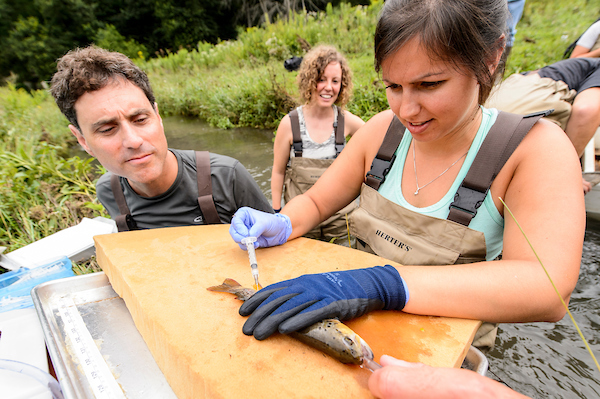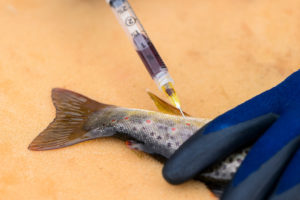Wisconsin Sea Grant-funded research is revealing a more detailed picture of the range of viral hemorrhagic septicemia virus (VHSV) in Wisconsin waters. This invasive pathogen can cause affected fish to die. Since the early 2000’s, it has caused deaths in more than 30 fish species in the Great Lakes region.
The researchers’ findings have been published in the Journal of Aquatic Animal Health, a publication of the American Fisheries Society. The findings show that VHSV in Wisconsin can be found further inland and in more bodies of water than previously known.
Authors of the research paper (“Widespread Seropositivity to Viral Hemmorhagic Septicemia Virus in Four Species of Inland Sport Fishes in Wisconsin“) are Whitney A. Thiel, Kathy L. Toohey-Kurth, David Giehtbrock, Bridget B. Baker, Megan Finley and Tony L. Goldberg.
They key to discovering this new information was testing fish for the presence of antibodies to VHSV through a process known as enzyme-linked immunosorbent assay (ELISA). While the general method of ELISA is not new, the particular ELISA for VHSV is, and it was developed with Sea Grant support. “It’s a valuable tool in fish health testing,” said Goldberg, an epidemiology professor at the University of Wisconsin-Madison School of Veterinary Medicine.

In this July 2016 photo taken near Wauzeka, Wis., Whitney Thiel draws blood from a brown trout while Tony Goldberg observes. (Photo: Bryce Richter, UW-Madison)
While other, more common testing methods look for presence of the live virus, the new method detects past exposure to VHSV, which, said Goldberg, is “really useful for screening populations and looking back in time.” Blood samples are collected from fish in a non-lethal way.
The research team focused on four sport fish that are economically important in Wisconsin: bluegill, brown trout, northern pike and walleye. Fish with VHSV antibodies were found in 37 of 46 inland water bodies tested, including water bodies far from known outbreak events. Sampling occurred in 2016 and 2017.
Researchers found the results surprising. Said Thiel, first author of the journal article, “I suspected we’d see it spread out in some of the inland water bodies connected to the Winnebago watershed or the Green Bay area—where we already knew VHS was—but I didn’t expect we would see it so far inland.” Thiel completed a master’s degree in freshwater and marine sciences at UW-Madison in 2019 and is now a research scientist at the University of Idaho.
Another intriguing finding was what members of the team characterized as “hot spots” and “not spots,” which were often close together. Prior to the research, they expected that any additional instances of VHSV detected would be near bodies of water known to have problems. However, in a number of cases, a body of water with no evidence of VHSV could be found neighboring one with evidence of the virus.
Giehtbrock, fish culture section chief at the Wisconsin Department of Natural Resources, said that this new information was all the more reason for those using Wisconsin’s waters—like recreational boaters and anglers—to keep taking preventative steps against the spread of aquatic invasive species in general.
“We need to continue all those practices that have been in place for a long time, to mitigate any transfer of VHSV between bodies of water, which is what we were already asking people to do everywhere. From invasives like Eurasian watermilfoil to carp to VHSV, we’re already asking people to clean their boats, drain their live wells and not transfer water between bodies of water,” said Giehtbrock.
“What people should take away from this is, we want to keep it out of where it’s not,” echoed Goldberg.
Giehtbrock, who supervises DNR fish hatcheries around the state, does not foresee a change in fish stocking practices at this point. Citing both Department of Agriculture regulations and the DNR’s own policies, he said that managing the health of fish for stocking is already strictly controlled.

Blood samples were drawn from fish in a non-lethal way. In this 2016 photo, a sample is taken from a brown trout. (Photo: Bryce Richter, UW-Madison)
“VHSV is one big component of that,” explained Giehtbrock. “We do virus testing on all of the stocks prior to their departure from the hatchery for stocking. So in terms of actual stocking practice, I don’t see a change because we’re already doing all the testing and monitoring that is feasible to make sure that everything we put out there is healthy and not spreading disease.”
Where Giehtbrock does see a possible change, however, is on the demand side, if more fish are needed to maintain or supplement fisheries being affected by VHSV fish kills. However, such a situation has not occurred yet.
This new information paints a more accurate and complex picture of VHSV in Wisconsin than previously understood. The research team recommended vigilance against potentially spreading the virus or other invasives. The best offense is a good defense, such as adhering to current advice promoted by the “Clean Boats, Clean Waters” campaign and similar initiatives.
The post Research reveals a more accurate picture of the occurrence of VHSV in Wisconsin waters first appeared on Wisconsin Sea Grant.
News Releases – Wisconsin Sea Grant
News Releases – Wisconsin Sea Grant
https://www.seagrant.wisc.edu/news/research-reveals-a-more-accurate-picture-of-the-occurrence-of-vhsv-in-wisconsin-waters/
